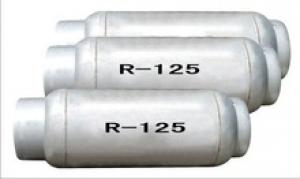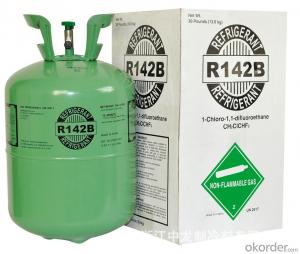Refrigerant R143a in Disposable Cyl
- Loading Port:
- Shanghai
- Payment Terms:
- TT OR LC
- Min Order Qty:
- -
- Supply Capability:
- 1000MT m.t./month
OKorder Service Pledge
Quality Product, Order Online Tracking, Timely Delivery
OKorder Financial Service
Credit Rating, Credit Services, Credit Purchasing
You Might Also Like
Specifications
1, refrigeratn gas R143a
2, ODP 0
3, GWP 4300
4, Purity,99.9%
5, 926L ton cylinder for export, 680kg/cyl, 8mm or 10mm
1,1,1-Trifluoroethane (HFC-143a)
refrigerant gas R143a
Application:HFC-143a is used as a special type of refrigerant or make blend refrigerants such as R404,R408,R507.
Packing: refillable cylinder-400L,800L,926L,1000L
Export: 926L, 680KG/CYLINDER, 14CYLS/FCL
| Molecular formula | CH3CF3 |
| Molecular weight | 84.04 |
| Boiling point 101.3KPa(°C) | -47.2 |
| Freezing point 101.3KPa(°C) | -111 |
| Density 30°C(kg/m3) | 1300 |
| Critical temperature(°C) | 72.9 |
| Critical pressure(MPa) | 3.78 |
| ODP | 0 |
| GWP | 4300 |
| Purity | ≥99.9% |
| Water content | ≤0.001% |
| Acidity | ≤0.00001% |
| Evaporation residue | ≤0.01% |
| Chloride content | - |
| Appearance | Colorless and clear |
| Odor | Odorless |
- Q: What is carbohydrate? What is organic? What is it?
- Compounds associated with the body (a few of the body-related compounds are inorganic compounds, such as water), usually carbon-containing compounds, but some simple carbon compounds such as carbon monoxide, carbon dioxide, carbonates, metal carbides, cyanides And so on. In addition to carbon containing elements, the vast majority of organic compounds containing hydrogen molecules in the molecule, and some also oxygen, nitrogen, halogen, sulfur and phosphorus and other elements. There are nearly 6 million organic compounds known. In the early days, organic compounds were substances that were obtained from animals and plants. Since 1828, the boundary between organic matter and inorganic matter disappears after artificial synthesis of urea [(NH2) 2CO], the term "organic" is still used for historical and customary reasons. Organic compounds are of great importance to humans, and all forms of life on earth, mainly composed of organic matter. For example: fat, amino acids, protein, sugar, heme, chlorophyll, enzymes, hormones and so on. Biological metabolism and biological genetic phenomena, are related to the transformation of organic compounds. In addition, many substances closely related to human life, such as oil, natural gas, cotton, dyes, chemical fiber, natural and synthetic drugs, are organic compounds.
- Q: What is the isomeric structure of oxygen-containing derivatives?
- Play the Transformers. As long as the same molecular formula, you can group out how many different structures, there are a number of isomers.
- Q: What does organic and inorganic mean?
- [Inorganic] inorganic is inorganic compounds referred to, usually refers to non-carbon compounds. A small number of carbon-containing compounds, such as carbon monoxide, carbon dioxide, carbonates, cyanides, etc. are also inorganic. Inorganic materials can be divided into oxides, acids, alkalis, salts and so on. Organic compounds Definitions Organic compounds usually refer to carbon-containing compounds, or hydrocarbons, and their derivatives, are collectively referred to as organic compounds.
- Q: Hydrocarbons and hydrocarbon derivatives are not all non-electrolytes
- Hydrocarbons are, derivatives are not necessarily, such as organic acids (formic acid, acetic acid, etc.)
- Q: The aromatic hydrocarbon derivative refers to monocyclic or polycyclic
- To see what is the derivative of aromatic hydrocarbons, by its own is a single ring or multi-ring decision
- Q: Is steel not organic synthetic material?
- Organic compounds that are organic compounds. Carbon compounds (carbon monoxide, carbon dioxide, carbonic acid, carbonates, metal carbides, cyanide excluded) or hydrocarbons and their derivatives in general. Most of the combustion can produce carbon dioxide and water.
- Q: Why not ah?
- A series of compounds in which a hydrogen atom in a hydrocarbon molecule is replaced by another atom or radical is called a derivative of a hydrocarbon
- Q: Rush! Hydrocarbon and hydrocarbon derivatives system information includes chemical formula, common name, Chinese name and so on
- The system is too difficult to summarize. Too much.
- Q: Why artemisinin and its derivatives in the molecular structure of a peroxide chain, the chemical properties are more stable?
- Artemisinin is relatively stable, is relative to other organic peroxide in terms of, in general, most of the organic peroxide instability, heating easily decomposed, and some even easy to burn the explosion, such as dibenzoyl peroxide, but crystal cyan Artemisinin heating to the melting point does not break down, has been considered stable.
- Q: How the most primitive life on earth is produced under what conditions
- In the 4 billion years ago, the Earth's water environment, the atomic group into molecules, the formation of a new four-balance body, and the Earth in the formation process, has gathered a lot of interstellar organic molecules, these molecules combined into macromolecules, Of the gravitational field and the anti-gravitational field to find the appropriate combination of objects. Macromolecules, molecules and atoms are also dependent on the formation of the force field to find the appropriate combination of objects, the formation of a new complex four-force balance body, where the gravitational field to play a long-range attraction (5-20 atomic diameter), which It also limits the macromolecules to obtain the desired combination of objects on a large scale, so macromolecules are combined into a moving tissue form, the most primitive marine microorganism. The macromolecules that move can mainly use the method of orienting the electromagnetic force to gradually develop into the original tissue that can swim in the water, so they can obtain a large amount of food (four-force balance) and accumulate some molecules in the body , These molecules in the original microbial parent force field guidance, combined with the mother similar to the new micro-organisms, these primitive microorganisms is essentially a complex macromolecule formation of the four balance body, which is the prototype of biological gene replication.
Send your message to us
Refrigerant R143a in Disposable Cyl
- Loading Port:
- Shanghai
- Payment Terms:
- TT OR LC
- Min Order Qty:
- -
- Supply Capability:
- 1000MT m.t./month
OKorder Service Pledge
Quality Product, Order Online Tracking, Timely Delivery
OKorder Financial Service
Credit Rating, Credit Services, Credit Purchasing
Similar products
Hot products
Hot Searches
Related keywords























